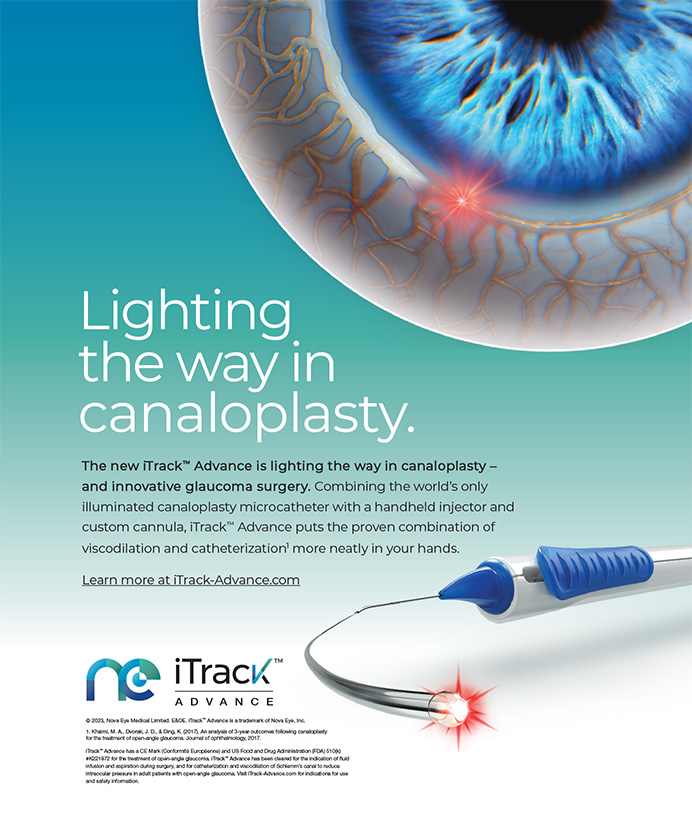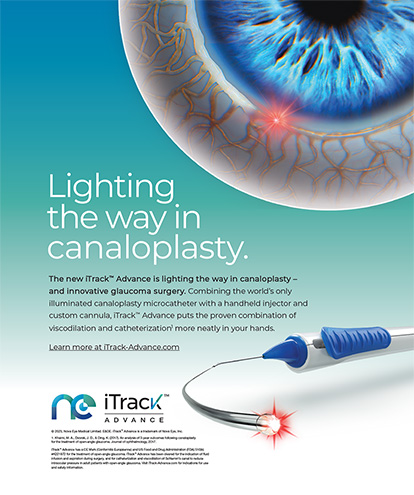When correcting astigmatism, cataract surgeons are striving to improve the patient's quality of vision and life while preserving corneal integrity. Particularly in cases of high astigmatism, treatment requires the use of multiple modalities. This article shares experience-based advice on astigmatic correction with an emphasis on managing high degrees of cylinder.
LIMBAL RELAXING INCISIONS
Surgeons use preoperative keratometry and topography to determine the amount, axis, and symmetry of the corneal cylinder. These methods frequently differ, however, due to the various ways in which the instruments acquire the readings. In the event of a discrepancy, I rely on the surgical keratometer as the final arbiter. Using this device ensures the most accurate placement and length of the corneal or limbal relaxing incision (LRI). I have found the surgical keratometer to be vital in the OR, and I believe it to be even more accurate than corneal topography.
By starting conservatively and increasing the length and number of incisions as warranted by the surgical keratometer's reading, I can avoid producing large over- and undercorrections. I operate on a plus keratometric cylinder during cataract surgery and operate on refractive cylinder in postoperative pseudophakic patients.
I create LRIs with a diamond micrometer knife (Katena Products, Inc., Denville, NJ). I place the incisions on the steep axis at the limbus, just anterior to the Palisades of Vogt. When performing LRIs alone, I determine their number and length according to the nomogram presented in Table 1 and confirm the result with the surgical keratometer. This nomogram, which titrates surgery by the length and number of LRIs, is only a starting point. The length and placement of incisions can vary based on topography and other factors. In eyes with 4.00 to 6.00D of cylinder, the goal is to reduce cylindrical power and absolutely avoid overcorrecting with-the-rule cases (so as to minimize against-the-rule astigmatism). In eyes with < 0.50D of cylinder, I make only an astigmatically neutral cataract incision.
TORIC IOLs
Using a toric IOL reduces the cylinder without additional corneal surgery in many cases. For most astigmats, the amount of cylindrical correction afforded by a toric lens (1.40 and 2.40D of astigmatism by a 2.00 and 3.50D toric lens, respectively) is sufficient to provide a nearly emmetropic refraction. Because the STAAR Toric lens (STAAR Surgical Company, Monrovia, CA) is currently available with only two toric add powers, the IOL can only partially correct eyes with high astigmatism, so the residual cylinder can often continue to decrease patients' quality of vision. One may piggyback toric lenses to double the effective correction (discussed in more detail later) or combine the implantation of a toric IOL with other techniques for correcting astigmatism such as astigmatic keratotomy and excimer laser ablation.
In my experience, using the surgical keratometer ensures the most accurate placement of the toric lens, because even a small, sutureless cataract incision can alter the axis of astigmatism. The precise placement of the IOL at the steep axis is especially important for patients receiving piggyback toric lenses, since any reduction in effect caused by a slightly off-axis placement is doubled.
If the toric lens is implanted or rotates off axis, the surgeon can reposition it. IOLs usually do not rotate on their own once capsular fusion takes place, and they are difficult to rotate surgically more than 2 weeks postoperatively, because breaking the adhesions risks zonular disruption. In the minor procedure room, I routinely rotate toric lenses with a 30-gauge needle on a syringe. After anesthetizing the cornea with topical Alcaine (Alcon Laboratories, Inc., Fort Worth, TX) and Xylocaine jelly (Astrazeneca LP, Wilmington, DE), I enter the anterior chamber with the needle at the desired axis of rotation. Before rotating the lens into the correct position, I free it for 360° with a gentle rocking motion that loosens any adhesions. The tip of the needle is simply placed along the edge of the lens, which is easily rotated into position.
STRATEGIES FOR HIGH ASTIGMATISM
Overview
For patients with 8.00D or more of astigmatism, surgeons may piggyback two toric lenses, even if the patient would not otherwise require piggyback implantation for high hyperopia. The advantage of this technique is that it can correct up to 8.00D of cylinder while leaving the cornea virtually untouched. If the patient requires further correction postoperatively, the surgeon may perform LRIs on what is essentially a virgin cornea.
I have implanted piggyback toric lenses in a relatively small number of patients. I have encountered few problems of postoperative rotation and no counter-rotations. Suturing the IOLs together necessitates a longer cataract incision, which, if placed at the steep axis, can actually be useful for correcting some of the astigmatism. One must, of course, take into account the impact of the cataract incision on the corneal astigmatism when calculating the amount of desired correction.
When suturing toric lenses together, the surgeon holds the edges of the lenses with a soft lens grabber. The IOLs are secured with tying forceps and 9?0 nylon, with one throw and one knot through the fixation holes at each end.
CASE EXAMPLES
No. 1
A patient presents with 11.50D of astigmatism (Figure 1A) and a refraction of 8.50 -6.00 X060 OD. He had a previous corneal transplant and was amblyopic. The patient undergoes cataract surgery and receives a toric IOL with a 7-mm corneal relaxing incision at the 10:30-o'clock position, 8-mm optical zone. Six weeks postoperatively, he returns with a refraction of plano sphere and 20/40 UCVA. The topographic maps show 2.71D of astigmatism at 35° (Figure 1B).
No. 2
A patient presents with 7.51D of astigmatism (Figure 2A) and a refraction of -2.00 -4.00 X090 OD. He has a mature cataract and has undergone no previous eye surgery. During cataract surgery, he receives a toric IOL along with a 5.0-mm LRI at the 3-o'clock position and a 3.0-mm corneal relaxing incision at the 9-o'clock position. Two weeks postoperatively, the patient has a refraction of -0.25 -0.75 X090 and a UCVA of 20/40. His topographic maps show 1.45D of astigmatism (Figure 2B). At the 6-month postoperative visit, the patient's refraction measures -0.25 -0.75 X095, and he has a UCVA of 20/30 3. Topography shows 2.11D of astigmatism at 88° (Figure 2C).
No. 3
A patient presents with 8.73D of astigmatism at 91° (Figure 3A) and a refraction of -1.50 -4.50 X090 OS. He has no history of eye surgery. The patient undergoes cataract surgery with two toric IOLs and a 7.0-mm scleral incision. His target refraction is -1.75D, and he has a corneal potential of 20/63 UCVA. Three months postoperatively, the patient has a refraction of -2.75D sphere and sees 20/40 uncorrected. The topography shows 7.64D of astigmatism at 83° (Figure 3B).
CONCLUSION
For today's cataract surgeon, correcting astigmatism is a great value-added service. Whether the patient is receiving an LRI or a toric lens, a surgeon's employing various strategies for a complete approach to managing cylinder can maximize the correction afforded to both moderate and high astigmats.
James P. Gills, MD, is Founder and Director of St. Luke's Cataract & Laser Institute in Tarpon Springs, Florida. He acknowledged no financial interest in the products or companies mentioned herein. Dr. Gills may be reached at (800) 282-9905; jgills@stlukeseye.com.


